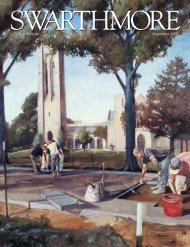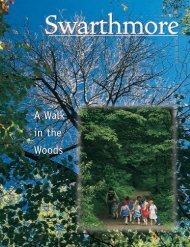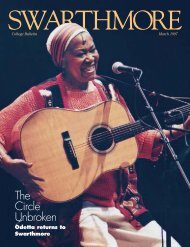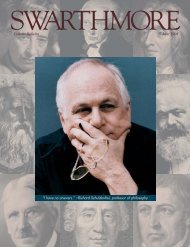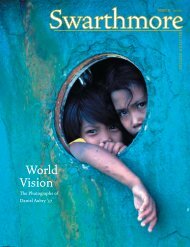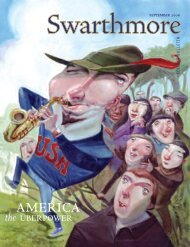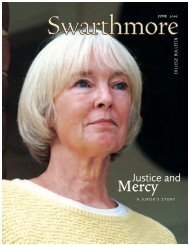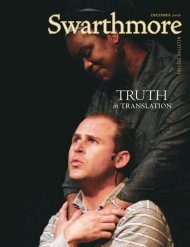SWARTHMORE
Swarthmore College Bulletin (September 2000) - ITS
Swarthmore College Bulletin (September 2000) - ITS
- No tags were found...
Create successful ePaper yourself
Turn your PDF publications into a flip-book with our unique Google optimized e-Paper software.
A L U M N I P R O F I L ES W A R T H M O R E C O L L E G E B U L L E T I NW a l k i n g f o r P e a c e“ S P I R I T U A L I T Y I S T H E H I G H E S T F O R M O F P O L I T I C S , ” S A Y S C R I S P I N C L A R K E ’ 9 8 .CRISPIN CLARKE ’98 IS WALKING FROM SAN FRANCISCOTO NEW YORK AS PART OF THE UNITED NATIONS’ 55TH-ANNIVERSARY GLOBAL PEACE WALK. THE WALKERS HOPETO REACH WASHINGTON, D.C., BY EARLY OCTOBER ANDWILL THEN MOVE ON TO NEW YORK, WITH A PROJECTEDSTOP IN <strong>SWARTHMORE</strong>. FOR MORE INFORMATION, VISITWWW.GLOBALPEACENOW.ORG.JIM GRAHAMWhen Crispin Clarke walked intomy Parrish Hall office lastspring, I thought the conversationwas going to be political. The youngactivist had called a few weeksbefore, saying he was going to be oncampus and would like to discuss anarticle for the Bulletin about the projecthe is working on—the UnitedNations’ 55th-Anniversary GlobalPeace Walk. As sometimes happenswhen a Swarthmorean gets fired upabout a cause, I braced myself for amessage, an agenda, and a plea forpublicity.But the conversation wasn’t politicalat all; it was spiritual. Clarke iswalking across the United Statesbecause he is searching for something—forhimself and for the rest ofus. What he is seeking, he says, is “areestablishment of a spiritual relationshipwith the elements: earth,water, fire, and air.”For Clarke, the walk is a way ofgetting his life “in balance.” He’sbeen living in a tepee in northernNew Mexico (“an Earth ship, madefrom recycled materials”), learningceramics and building a kiln (“potteryis from the Earth”), and workingto build a sustainable communitywith others of like mind (“some peopleweave, some fix cars, and someraise goats and chickens”).But instead of planting vegetablesin Taos this spring, he joined a groupof about 20 other seekers of peaceon a trek from San Francisco to NewYork that will end at the UnitedNations on Oct. 25, the world body’s55th anniversary.Led by Yusen Yamato, a Buddhistmonk from Japan, the marcherscarry drums, chimes, flags, andsigns. They stop at cities and townsalong the way, declaring “globalpeace zones,” holding rallies andIndian-style powwows and seekinglocal support for causes that rangefrom stopping nuclear proliferationto alternative medicine and from theuse of industrial hemp as a naturalmaterial to changing the calendar toa year of 13 moons.The main goal, however, is “a profoundspiritual and environmentalsummit at the United Nations” thisfall.If it sounds way out and countercultural,it is. But as Clarke talked,his mind jumping from issue to issue,he kept returning to the meaning ithad for him. “A lot of it is internal,”he said, recalling a trip to post–civilwarEl Salvador, where he was ableto “peer inside” and see that “theFirst World lives in a bubble whilethe Third World is suffering behindbarbed wire fences and pollution,barely hanging on to its culture inthe face of poverty.” He saw much ofthe same in the troubled Mexicanprovince of Chiapas, where he wentas an undergraduate, part of a peacestudies mission led by Assistant Professorof Spanish Aurora Camachode Schmidt.Clarke thinks that the First World,with its nuclear weapons and powerplants, appetite for natural resources,and attitudes that celebratehuman dominance over the environment,has a lot to learn. He sighs ashe talks about the “velocity of modernsociety,” how it’s spinning out ofcontrol. “On the walk, the trees standstill, and the trucks fly by. It’s actuallydangerous; one little swerve of thewheel and....”He’s quiet for a moment, waitingfor another question from me. ButI’m quiet, too. We listen as birds rustlein the shrubs outside the openoffice window. It’s a fine spring day.Yet questions come: Why are youdoing this? Why spend a year of yourlife trying to change things that mostpeople think cannot be changed?What is the source of your idealism?In a Zen-like answer, he refers backto ceramics, to the clay, and our relationshipto the Earth: “It starts withthe relations between your neighborand yourself. People have to learn tocooperate beyond race, gender, ideology,and religion in order to protectour land and life for future generations.If I don’t make this walk, whatwill happen to Mother Earth? Youjust have to try to do something.”—Jeffrey Lott66



